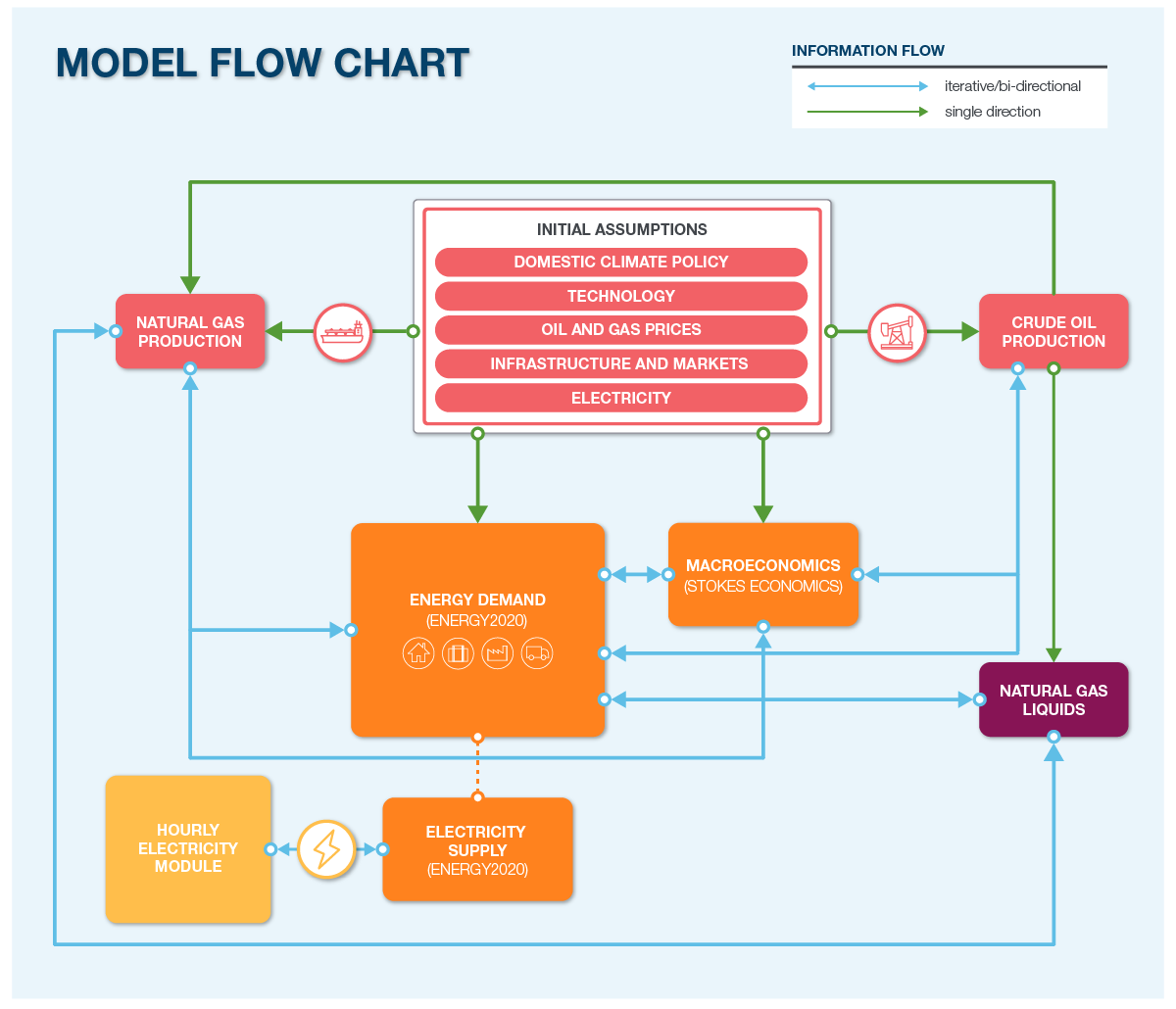The CER has issued an errata to correct several errors in the report
Appendix 2: Overview of the Energy Futures Modeling System

Energy Futures includes a wide range of projections for Canadian energy supply and demand. These projections are the result of a modeling system consisting of several interactive components (or modules) which produce future Canadian energy trends. Figure A2.1 outlines the system in a diagram.
Figure A2.1: Energy Futures Modelling Framework Flow Chart

Description
Description: This figure shows the modelling framework that is used in EF2021. There are seven interconnected models that we use: crude oil production, natural gas production, natural gas liquids production, energy demand, macroeconomic, electricity supply, and hourly electricity supply. Initial assumptions are used as inputs to crude oil and natural gas production models, in addition to macroeconomic and energy demand models. The crude oil production outputs are used as inputs to the natural gas production, and natural gas liquids models. Natural gas production outputs are used as inputs to the natural gas liquids model. Outputs from the natural gas, natural gas liquids, and crude oil production models are used as inputs to our energy demand and macroeconomic models. The hourly electricity supply model’s outputs are used as inputs to the electricity supply model and the energy demand model.
In EF2021, the full Energy Futures Modeling System is used to create projections for the Evolving and Current Policies Scenarios. The six Towards Net-Zero electricity scenarios were modeled using the hourly electricity module.
Overview of Model Components
Initial Assumptions: The starting point for Energy Futures analysis is the development of initial assumptions on various aspects of the global and Canadian energy system. Benchmark crude oil and natural gas price assumptions are based on a survey of projections by other forecasting agencies like the IEA and the U.S. Energy Information Administration, complemented by internal analysis. It is important to note that these assumptions are not predictions of future crude oil and natural gas prices, but necessary inputs for the analytical process. Other starting assumptions include energy and climate policies and programs, scenario details such as technology fuel pathways, and volumes of LNG exports.
Oil Production: This module provides crude oil production projections for the various regions and crude types in Canada, based on our price assumptions and other factors such as carbon pricing and technological improvements. It includes an oil sands module, and non-oil sands deliverability module for western Canada, and analysis of other regions in Canada.
Gas Production: This module estimates the production of natural gas throughout Canada. The module relies upon oil and natural gas price assumptions, LNG export assumptions, as well as a crude oil production estimated from the oil supply module and other factors such as technological change and policies. The module includes the Western Canadian Sedimentary Basin natural gas deliverability model, as well as trend analysis for other producing regions (e.g. New Brunswick).
Macroeconomics: Macroeconomic projections for each of the scenarios were provided by Stokes Economic Consulting Inc. Stokes developed unique projections of key macroeconomic indicators such as GDP, exchange rate, and industry gross output for each of the scenarios, based on the price assumptions and output of the CER’s supply and demand models.
Demand: The demand projections are developed using ENERGY2020: a detailed energy model created by Systematic Solutions Incorporated. It creates projections for energy demand and electricity generation based on historical energy data and, where needed, assumed future trends for parameters such as supply, demand, economic growth, efficiency, prices, and investment.
Electricity: The electricity projections are developed using ENERGY2020: a detailed energy model created by Systematic Solutions Incorporated. It creates projections for energy demand and electricity generation based on historical energy data, and where needed, assumed future trends for parameters such as supply, demand, economic growth, efficiency, prices, and investment. The ENERGY2020 projections are guided by the hourly electricity module, which provides increased temporal granularity which is important for analyzing how the system responds to increasing levels of variable renewable energy, storage, and transmission.
Natural Gas Liquids: This module provides estimates of NGL supply and demand in Canada. The module simulates various categories of liquids: ethane, butane, propane, condensate and pentane plus. For each liquid, the module provides estimates of production, supply and demand at the individual provincial/ territorial level.
- Date modified:
